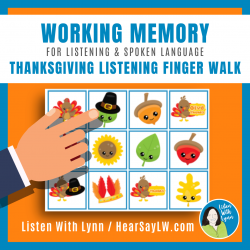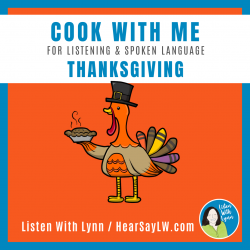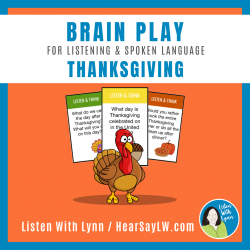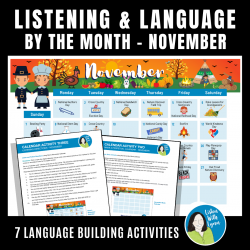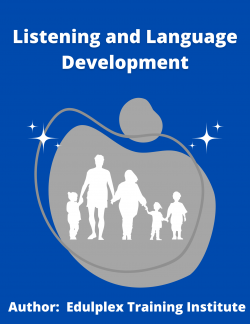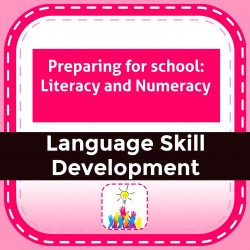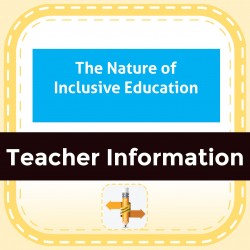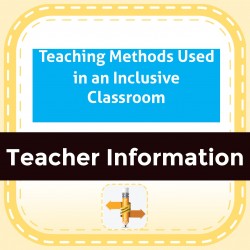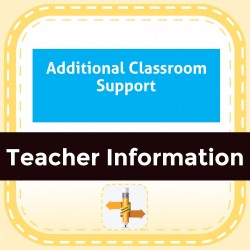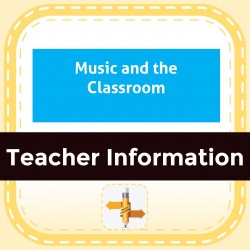Ability Levels
Categories
Resource Types
Age/Grade Range
CCSS
Anchor Standard
Speaking & Listening
Language
Reading
Working Memory THANKSGIVING Listening Finger Walk Game
$ 2
If you have kids that need help with auditory working memory, executive functioning, and following directions, the Fall Listening Finger Walks are a must-have!In addition to Thanksgiving, the Fall Lis
...
l Listening Finger Walks resource has 6 activities that are ideal for the first days of autumn through late November.Ideal For: Listening & Spoken Language, Executive Functioning, Deaf & Hard of Hearing, Auditory Processing, Speech, Auditory Verbal Therapy, ELA, Teletherapy, Home...Working memory is one of the brain's executive functions. Working memory plays a big role in how we auditory process, use, and remember information on a daily basis. Children and teens who have a hard time “staying on track” might have problems with something called working memory.The Thanksgiving Listening Walk is FUN for the kids and SIMPLE for you!➯ The Listening Walk can help build listening skills and working memory by allowing kids to work with auditory information without losing track of what they're doing.➯ The game targets vocabulary, descriptive skills, spoken language, and communication skills.➯ The game has three rounds that increase in auditory complexity.Game PlayYou need one listening game sheet per child.The child listens and follows verbal directions while walking their fingers around the grid until they hear STOP. They are using their working auditory memory to follow directions without losing track of what they were doing.Then, ask them to describe that block which is a great language expansion opportunity.If correct, they landed on a specific image and completed that round.Let the child take turns giving you directions. This helps build expressive language and turn-taking skills.Resource Includes:Listening and Spoken Language TipsDirections - No Prep!Thanksgiving Objects Listening Finger Walk GameGame Prep Print Version: Easy one-time prep. Print the game card and laminate them if you wish.No Prep - Digital Version: Play on a computer with your favorite PDF reader app or on a tablet. When playing on a computer, open and use a PDF reader such as the free Adobe Acrobat Reader DC. The child uses their finger or the annotation tools to mark their walking path on the game cards.◈ ◈ ◈ ◈ ◈ ◈ ◈ ◈ ◈ ◈ ◈ ◈ ◈ ◈ ◈ ◈ ◈ ◈ ◈ ◈ ◈ ◈ ◈ ◈ ◈ ◈ ◈ ◈ ◈ ◈CUSTOMER TIPS:➼ Questions? Email me before purchasing this resource or anytime later
♥ Sign-up HERE for the Listen With Lynn Emails
Let’s Connect:InstagramFacebookKeep up your good work. I am blessed to help along the way. Thanks so much!Lynn
Cook With Me Listening and Language Fall and Thanksgiving
$ 5
8 Fall-themed recipes with minimal ingredients and steps provide authentic opportunities for children to listen, follow directions, and develop self-help skills. Preparing food, cooking, and cleaning
...
ng up expands vocabulary and introduces new concepts while encouraging thinking, problem-solving, and promoting literacy skills. Cooking together invites natural communication and conversational skills.Ideal for: Speech, Listening and Spoken Language, Auditory Verbal sessions, or lessons at school. Face to Face Lessons. Mixed groups. Parent-guided teletherapy. Send for home activities.Includes:★ 8 Recipes with Minimal Ingredients and Steps★ 6 Edible and 2 Craft Recipes★ Recall and Retell Sheet★ Listen and Learn Recipe Cookbook Cover★ Handout with Two Pages of Targets for Listening and Language Opportunities★ Encourages Thinking, Problem-Solving, and Promotes Literacy Skills★ Listening and Spoken Language (LSL) TipsEight Beautifully Designed Recipe CardsTurkey CookiesFruit CornucopiasTurkey QuesadillaChocolate AcornsPumpkin Pie in a CupPumpkin Snack MixPumpkin Cheesecake DipPumpkin Playdough (non-edible)Teletherapy, Distance Learning & Face to Face✢ Print✢ Digital to share on an iPad or computer screen◈ ◈ ◈ ◈ ◈ ◈ ◈ ◈ ◈ ◈ ◈ ◈ ◈ ◈ ◈ ◈ ◈ ◈ ◈ ◈ ◈ ◈ ◈ ◈ ◈ ◈ ◈ ◈ ◈ ◈CUSTOMER TIPS:➼ Questions? Email me before purchasing this resource or anytime later♥ Sign-up HERE for the Listen With Lynn Emails♥ Let’s Connect:InstagramFacebookKeep up your good work. I am blessed to help along the way. Thanks so much!Lynn
Listen and Think Thanksgiving Brain Play Activity
$ 5
Listen & Think Brainplay is a rich activity that targets listening, following directions, auditory processing, vocabulary, and comprehension skills.Ideal For: Listening & Spoken Language, Executive Fu
...
unctioning, Deaf & Hard of Hearing, Auditory Processing, Speech, Auditory Verbal Therapy, ELA, Teletherapy, Home...The more a child knows about a topic, such as Thanksgiving the easier it is to comprehend and retain the information. Background knowledge of recurring holidays and seasons is fundamental for language, academic, and communication success. Listen & Think Brainplay is not only a great way to grow Thanksgiving vocabulary but it fosters back-and-forth conversation. Research is clear that when children engage in serve and return interactions, activity increases in the parts of the brain responsible for listening and spoken language processing and production.Children who are deaf and hard of hearing as well as those students with limited language may struggle to increase their vocabulary because of weak auditory memory, difficulty with auditory comprehension, and lack of exposure. What's Included?28 Thanksgiving-related conversation starters, questions, and trivia topics.Answer sheet with space for data collectionFive suggested ways to playListening and Spoken Language (LSL) TipsEasy one-time prep. Print the game card and laminate them if you wish.◈ ◈ ◈ ◈ ◈ ◈ ◈ ◈ ◈ ◈ ◈ ◈ ◈ ◈ ◈ ◈ ◈ ◈ ◈ ◈ ◈ ◈ ◈ ◈ ◈ ◈ ◈ ◈ ◈ ◈CUSTOMER TIPS:➼ Questions? Email me before purchasing this resource or anytime later♥ Sign-up HERE for the Listen With Lynn Emails♥ Let’s Connect:InstagramFacebookKeep up your good work. I am blessed to help along the way. Thanks so much!Lynn
NOVEMBER Listening By the Month Vocabulary Comprehension Activities
$ 5
The NOVEMBER Listening and Language By The Month resource includes seven activities that can be used ALL MONTH for auditory memory and comprehension, seasonal vocabulary, developing grammar, and build
...
Listening and Language Development
$ 6
A child has been diagnosed with hearing loss and fitted with hearing devices. Up to this point, most of the ‘work’ has been done by health care professionals, while parents and family members observed
...
rved. After the fitting of hearing devices, parents, family members and teachers start to become actively involved in managing the child with hearing loss. Active participation at this stage requires parents and teachers to facilitate listening and language development. This is an exciting time for both the parent and the child with hearing loss as there is much that the parents can do throughout each day to stimulate listening and develop language skills.Parental involvement is one of the strongest predictors in a child developing spoken language, as they are the primary source of language that the child will be exposed to. Regardless of whether there is regular access to speech and language therapy, or any other form of therapy, there is much that parents and family members can do at home.
Preparing for school: Literacy and Numeracy
$ 6
Age-appropriate listening and language skills are required for any child to succeed at school. At school, more advanced developmental skills, namely literacy and numeracy skills, are developed. A pare
...
nt can already start to introduce basic literacy and numeracy concepts to a child as of birth. Parents do not always realize that preparing the child beforehand to learn each of these skills, is vital. Before children go to school, they need to acquire certain skills that will help them to read and write. This is the joint responsibility of the parents and the child’s educational team, such as the teacher of the deaf/hard of hearing, early intervention provider, speech-language therapist, and/or preschool teacher.Emergent literacy: Before teaching reading and writing skills, a child needs to know the processes and concepts involved in reading and writing. Emergent literacy skills discussed in this lesson include literacy socialization, phonological awareness, as well as printed word and alphabet knowledge. Reading is the process through which meaning is attached to written symbols and letters. It is about comprehending and actively responding to the content.Writing is the use of symbols to communicate thoughts and ideas. It is a way to represent language in a visual and tactile form. The development of the different components of emergent literacy, reading and writing is discussed in this lesson.
The Nature of Inclusive Education
$ 6
Choosing the most appropriate school for a child requires collaboration between the parents and the school. Together, they should decide which will be the best option for the child. This module define
...
s the concept of inclusive education, as well as the barriers which a child with hearing loss could experience. However, these barriers can be overcome through an attitude of determination, with ongoing training and self-enrichment on the part of the teacher and the broader community. Overcoming the barriers is imperative for inclusion to be successful. Inclusive education starts with parents advocating for their children with school management.Inclusion exposes a child with hearing loss to individualized teaching strategies. It requires additional support from family and the school team, which usually includes the classroom teacher and the teacher of the deaf/hard of hearing and may also include the speech-language therapist and other special education support staff in the child’s school.The purpose of inclusive education is to ensure that all children gain access to knowledge and skills that will make them socially and economically independent. The main requirement for inclusion is that the school must be willing to accept the challenge and adapt.
Teaching Methods Used in an Inclusive Classroom
$ 6
A child with hearing loss has been accepted in a mainstream school. Now inclusive education starts. This means that traditional teaching methods used, need to be adapted to accommodate the specific ne
...
eds of all children. This is done through differentiation. Differentiation is the process by which differences between children are accommodated to achieve the best learning results possible.An inclusive classroom can be effectively managed and facilitated, using differentiated teaching methods and an Individual Education Plan (IEP).These two strategies will define the necessary knowledge, skills and attitude that teachers require to include a child with hearing loss successfully in a mainstream school. This module explains how a child with hearing loss, who has similar academic potential as his peers, can learn and develop within a mainstream school. It describes how teachers can overcome barriers associated with learning, it gives practical guidelines on how to use differentiated teaching methods, and how to implement and use an IEP.
Additional Classroom Support
$ 6
The provision of differentiated teaching methods is not sufficient to support a child with hearing loss adequately in a mainstream school. Additional classroom support needs to be provided as well. Al
...
l of the classroom supports mentioned are very important to consider for students with hearing loss. What support and the degree of support needed should be based on assessment information that has been tailored to identify the specific educational performance needs of students with hearing loss.The services or supports provided will most often consist of specialized instruction detailed on the student’s Individualized Education Plan (IEP) and/or accommodations identified to address communication access issues of these students. Pull-out services by special educators, one-on-one with students or in small groups are usually necessary to meet specific needs. Push-in services where educational specialists work in a team-teaching model along with the classroom teacher or provide small group instruction in the classroom can often address some of the students’ language issues, social needs, and academic challenges.Regardless of current common practice, the array of supports described in this module should be considered by the school team, followed by discussions to determine intensity of intervention required for appropriate progress, who will provide these supports and services, and how best to meet the student’s educational performance with the goal of keeping pace with cognitive peers in the classroom.
Music and the Classroom
$ 6
In education, music plays a very important role. Music can remediate and habilitate when taught in a knowledgeable, loving and supportive environment. A research study conducted by the German Socio-ec
...
onomic Panel (2013), says this about music lessons: “Music improves cognitive and non-cognitive skills more than twice as much as sports, theatre or dance.” The study found that children, who take music lessons “have better cognitive skills and school grades and are more conscientious, open and ambitious.”Milestones in music and language can be measured from birth to nine years. These milestones are an indication of the child’s ability to hear (input), give meaning (process) and respond (output) to sound. Any parent or professional who has an interest in the influence of music on a child’s development will benefit from this module.Music will have an influence on the development of all children, regardless of the presence of impairment. For the purposes of this module, emphasis will be placed on the child with hearing loss, or a child with normal hearing and auditory processing disorder.
 Your browser is out of date. For best experience switch to latest updated Browser.
Your browser is out of date. For best experience switch to latest updated Browser.
 Get Chrome
Get Chrome Get Edge
Get Edge Get Firefox
Get Firefox